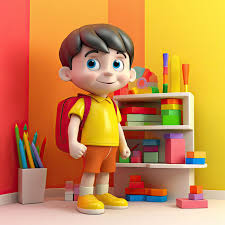The modern educational environment has witnessed a remarkable shift in how a teacher approaches curriculum design and delivery, particularly through the strategic incorporation of media. Among the most influential resources gaining recognition are kids animated shows, which offer unique pedagogical opportunities when thoughtfully integrated into learning experiences. Educators now serve as critical mediators between children and the vast landscape of animated content, helping students navigate this rich terrain with purpose and discernment.
Professional educators recognize that kids animated shows represent more than mere entertainment—they constitute a specialized form of educational technology with distinct advantages for cognitive development. The combination of narrative structure, visual stimulation, and auditory information creates multi-sensory learning experiences that accommodate diverse learning preferences. Teachers who skillfully leverage these programs transform passive screen time into active intellectual engagement that reinforces classroom objectives while sustaining student interest.
The neuroscience supporting animation as an educational tool continues to expand, revealing how animated sequences activate multiple brain regions simultaneously. This neural stimulation strengthens connections between visual processing centers, language areas, and memory consolidation pathways. When teachers select animated content aligned with specific learning outcomes, they capitalize on these natural cognitive processes, making abstract concepts more concrete and memorable through visual representation and narrative context.
Curriculum integration requires thoughtful planning to maximize the educational value of animated programming. Effective educators establish clear connections between animated content and learning standards, using preparatory activities to focus student attention on key concepts before viewing and reflective exercises afterward to process and apply new information. This structured approach ensures that animation serves as a catalyst for deeper learning rather than a distraction from educational goals.
Literacy development benefits substantially from well-chosen animated content that models rich language usage in meaningful contexts. Teachers guide students in analyzing dialogue, narrative structure, and character development, drawing explicit connections to reading and writing skills. Many educators have discovered that discussions about animated stories naturally lead to heightened engagement with related texts, creating a bridge between visual media and traditional literacy.
Mathematical thinking finds powerful support in animation that visualizes abstract numerical concepts. From basic counting sequences for younger learners to complex spatial relationships for older students, animated representations make mathematical principles tangible. Teachers who pair these visual demonstrations with hands-on activities create comprehensive learning experiences that address various cognitive approaches to mathematical understanding.
Scientific inquiry thrives when animated sequences illustrate processes too small, large, fast, or slow to observe directly. Cellular functions, geological formations, and astronomical phenomena become accessible through animation, allowing teachers to bring otherwise invisible systems into the classroom. The visual nature of these presentations helps students develop mental models that support deeper conceptual understanding of scientific principles.
Social-emotional learning represents perhaps the most significant contribution of quality animated programming to educational environments. Through carefully selected content, teachers help students explore complex emotional situations, ethical dilemmas, and interpersonal challenges from a safe distance. Animated characters model problem-solving strategies, emotional regulation techniques, and conflict resolution approaches that children can apply in their own social interactions.
Cultural awareness expands when teachers incorporate animated content featuring diverse characters and settings. Many contemporary programs deliberately showcase various cultural perspectives, family structures, and lived experiences, providing windows into worlds beyond students’ immediate environment. Thoughtful educators use these representations as starting points for discussions about diversity, equity, and inclusion that build empathy and broaden worldviews.
Assessment innovations emerge when teachers recognize the creative potential of animation-inspired projects. Students demonstrate understanding by creating storyboards, developing character analyses, or producing their own animated sequences that apply learned concepts. These performance-based assessments often reveal deeper comprehension than traditional testing methods while developing valuable communication and technical skills.
Professional collaboration among educators interested in animation’s educational potential has created communities of practice dedicated to developing best practices. These collaborative networks share resources, lesson plans, and implementation strategies that help teachers maximize the benefits of animated content while minimizing potential drawbacks like passive consumption or uncritical acceptance of media messages.

